Rashtin LLC: Performance Management, Work Investigations & Sector
VerifiedAdded on 2023/06/13
|20
|4414
|500
Report
AI Summary
This report delves into the performance management practices at Rashtin LLC, a private sector and Trade Support Institution (TSI). Part A investigates the learner's experiences within the organization, focusing on strategic planning, Key Result Areas (KRAs), and the performance appraisal process, highlighting key issues such as the emphasis on KRAs over Key Performance Indicators and the lack of a feedback system for staff to evaluate managers. Part B broadens the scope to include sector research, examining the challenges faced by private sector companies and TSIs, and contrasting Rashtin LLC's approach with that of the Malaysia External Trade Development Corporation (MATRADE). The report concludes with Part C, offering recommendations for improving performance measurement within Rashtin LLC, emphasizing the need for a balanced approach that incorporates both qualitative and quantitative targets, along with a robust feedback mechanism and a system for measuring lagged results. Desklib provides a wealth of similar assignments and study tools for students.
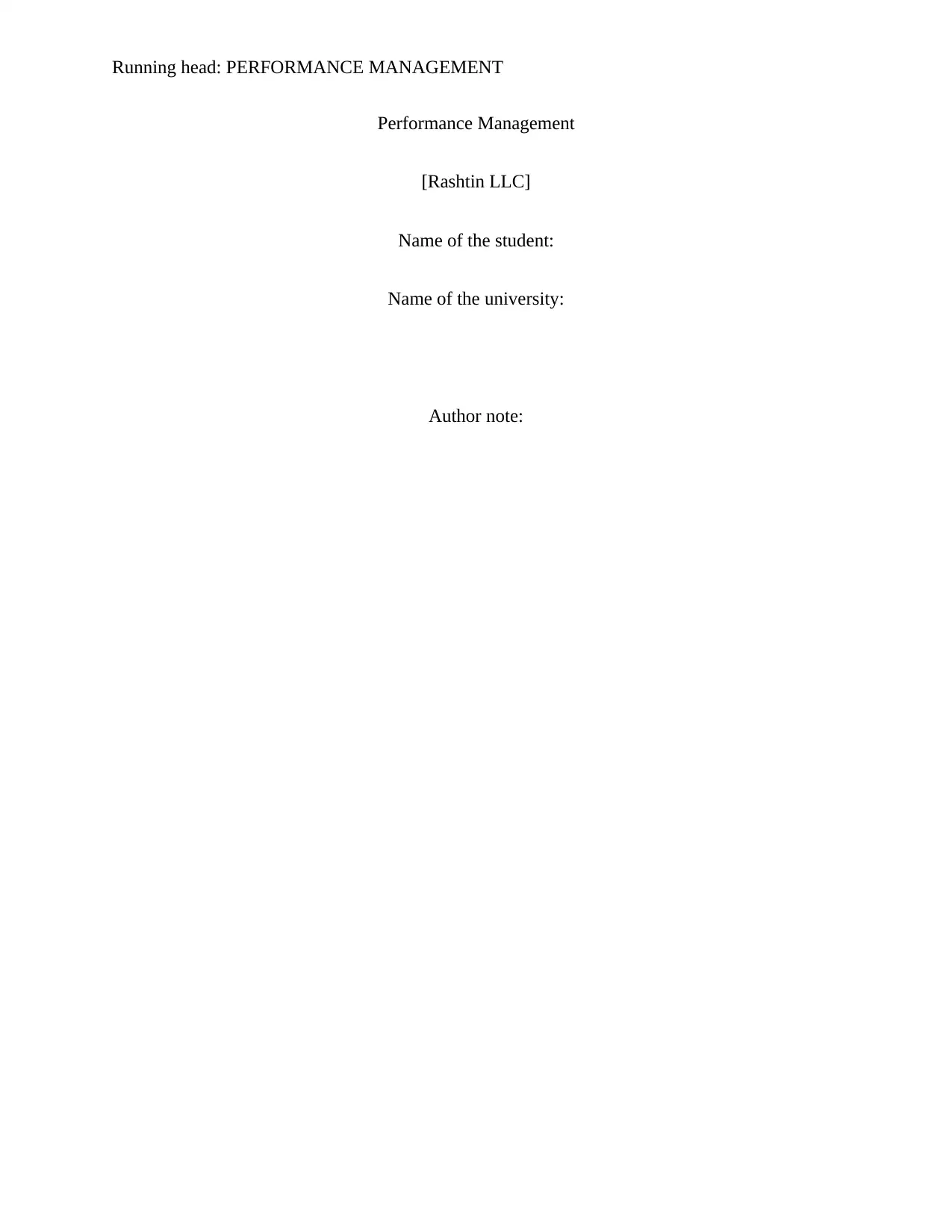
Running head: PERFORMANCE MANAGEMENT
Performance Management
[Rashtin LLC]
Name of the student:
Name of the university:
Author note:
Performance Management
[Rashtin LLC]
Name of the student:
Name of the university:
Author note:
Paraphrase This Document
Need a fresh take? Get an instant paraphrase of this document with our AI Paraphraser
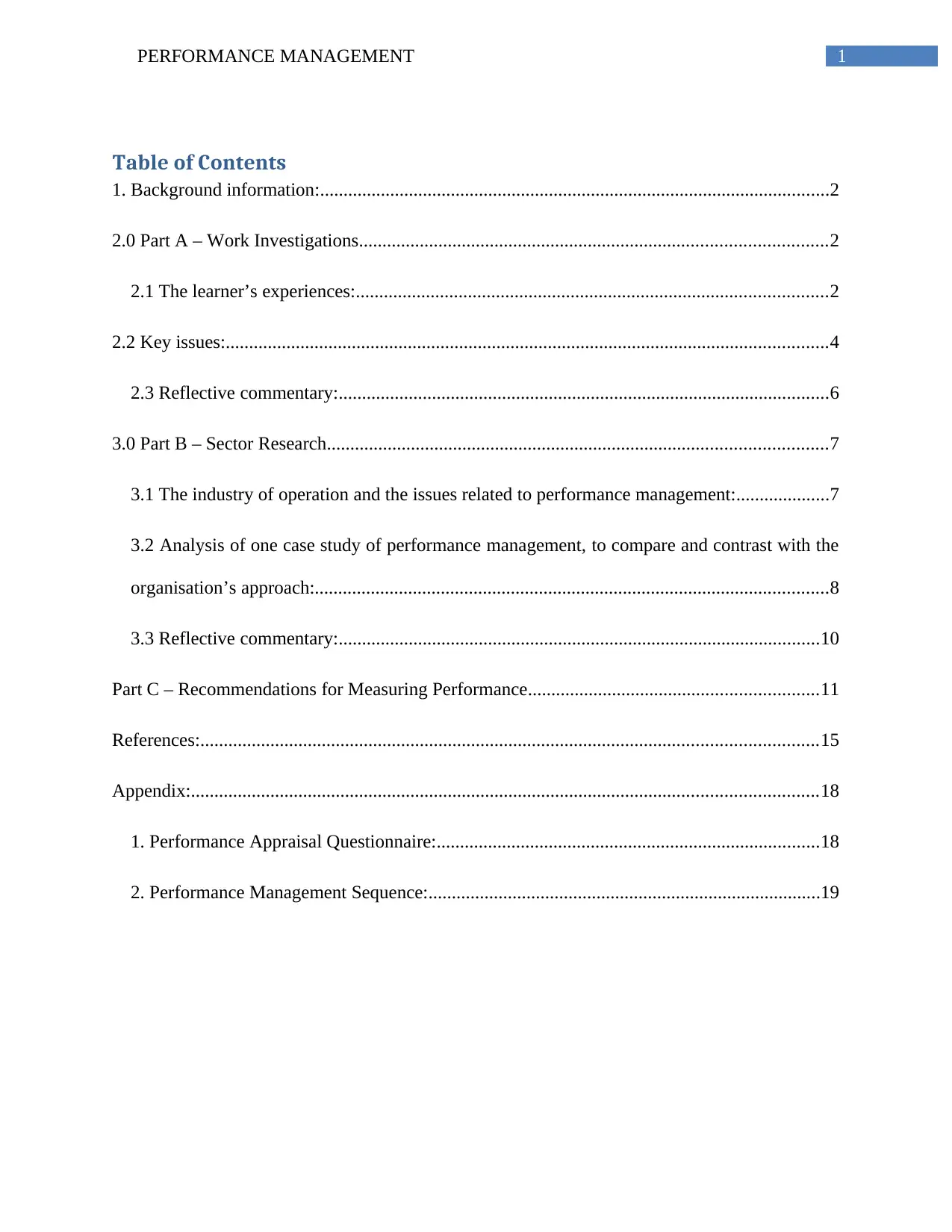
1PERFORMANCE MANAGEMENT
Table of Contents
1. Background information:.............................................................................................................2
2.0 Part A – Work Investigations....................................................................................................2
2.1 The learner’s experiences:.....................................................................................................2
2.2 Key issues:.................................................................................................................................4
2.3 Reflective commentary:.........................................................................................................6
3.0 Part B – Sector Research...........................................................................................................7
3.1 The industry of operation and the issues related to performance management:....................7
3.2 Analysis of one case study of performance management, to compare and contrast with the
organisation’s approach:..............................................................................................................8
3.3 Reflective commentary:.......................................................................................................10
Part C – Recommendations for Measuring Performance..............................................................11
References:....................................................................................................................................15
Appendix:......................................................................................................................................18
1. Performance Appraisal Questionnaire:..................................................................................18
2. Performance Management Sequence:....................................................................................19
Table of Contents
1. Background information:.............................................................................................................2
2.0 Part A – Work Investigations....................................................................................................2
2.1 The learner’s experiences:.....................................................................................................2
2.2 Key issues:.................................................................................................................................4
2.3 Reflective commentary:.........................................................................................................6
3.0 Part B – Sector Research...........................................................................................................7
3.1 The industry of operation and the issues related to performance management:....................7
3.2 Analysis of one case study of performance management, to compare and contrast with the
organisation’s approach:..............................................................................................................8
3.3 Reflective commentary:.......................................................................................................10
Part C – Recommendations for Measuring Performance..............................................................11
References:....................................................................................................................................15
Appendix:......................................................................................................................................18
1. Performance Appraisal Questionnaire:..................................................................................18
2. Performance Management Sequence:....................................................................................19
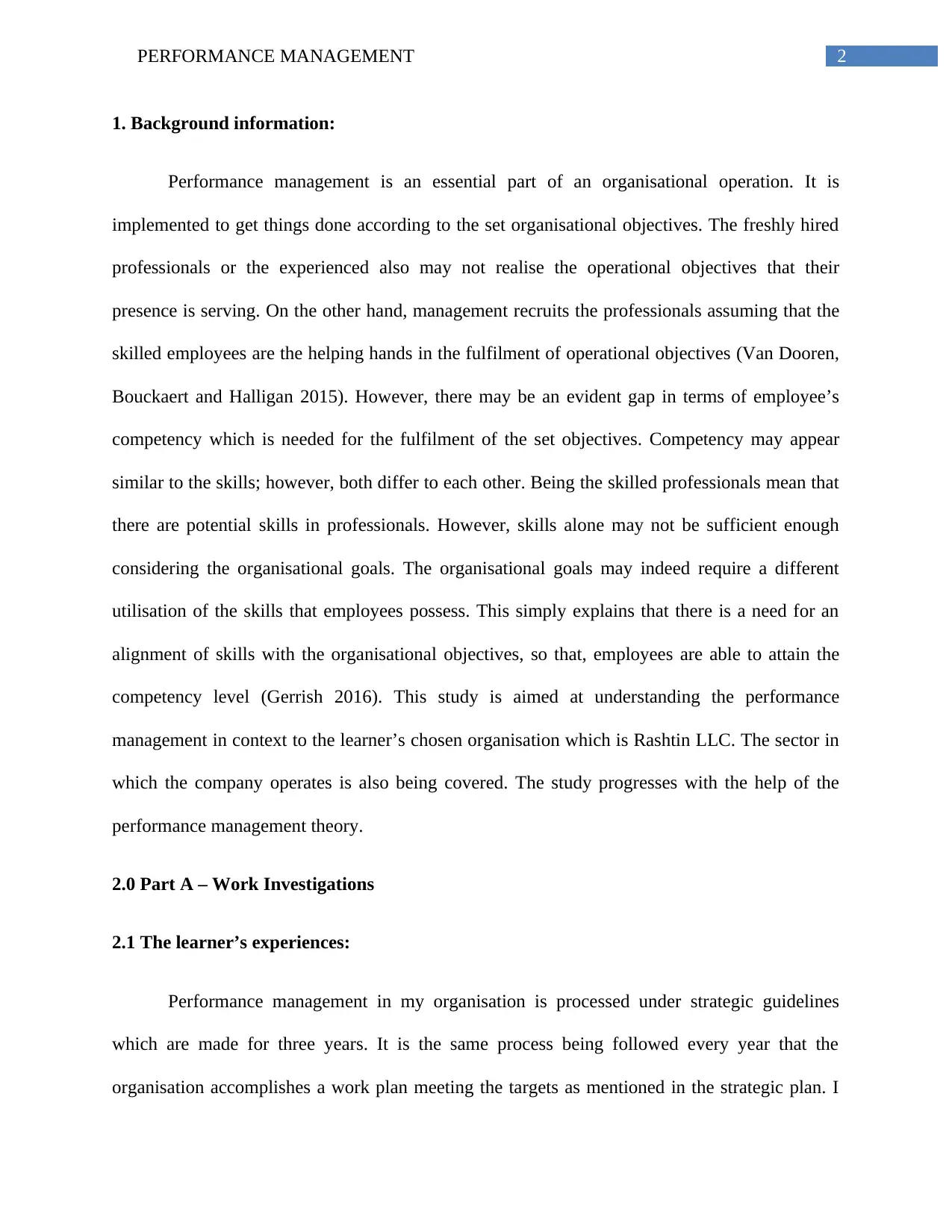
2PERFORMANCE MANAGEMENT
1. Background information:
Performance management is an essential part of an organisational operation. It is
implemented to get things done according to the set organisational objectives. The freshly hired
professionals or the experienced also may not realise the operational objectives that their
presence is serving. On the other hand, management recruits the professionals assuming that the
skilled employees are the helping hands in the fulfilment of operational objectives (Van Dooren,
Bouckaert and Halligan 2015). However, there may be an evident gap in terms of employee’s
competency which is needed for the fulfilment of the set objectives. Competency may appear
similar to the skills; however, both differ to each other. Being the skilled professionals mean that
there are potential skills in professionals. However, skills alone may not be sufficient enough
considering the organisational goals. The organisational goals may indeed require a different
utilisation of the skills that employees possess. This simply explains that there is a need for an
alignment of skills with the organisational objectives, so that, employees are able to attain the
competency level (Gerrish 2016). This study is aimed at understanding the performance
management in context to the learner’s chosen organisation which is Rashtin LLC. The sector in
which the company operates is also being covered. The study progresses with the help of the
performance management theory.
2.0 Part A – Work Investigations
2.1 The learner’s experiences:
Performance management in my organisation is processed under strategic guidelines
which are made for three years. It is the same process being followed every year that the
organisation accomplishes a work plan meeting the targets as mentioned in the strategic plan. I
1. Background information:
Performance management is an essential part of an organisational operation. It is
implemented to get things done according to the set organisational objectives. The freshly hired
professionals or the experienced also may not realise the operational objectives that their
presence is serving. On the other hand, management recruits the professionals assuming that the
skilled employees are the helping hands in the fulfilment of operational objectives (Van Dooren,
Bouckaert and Halligan 2015). However, there may be an evident gap in terms of employee’s
competency which is needed for the fulfilment of the set objectives. Competency may appear
similar to the skills; however, both differ to each other. Being the skilled professionals mean that
there are potential skills in professionals. However, skills alone may not be sufficient enough
considering the organisational goals. The organisational goals may indeed require a different
utilisation of the skills that employees possess. This simply explains that there is a need for an
alignment of skills with the organisational objectives, so that, employees are able to attain the
competency level (Gerrish 2016). This study is aimed at understanding the performance
management in context to the learner’s chosen organisation which is Rashtin LLC. The sector in
which the company operates is also being covered. The study progresses with the help of the
performance management theory.
2.0 Part A – Work Investigations
2.1 The learner’s experiences:
Performance management in my organisation is processed under strategic guidelines
which are made for three years. It is the same process being followed every year that the
organisation accomplishes a work plan meeting the targets as mentioned in the strategic plan. I
⊘ This is a preview!⊘
Do you want full access?
Subscribe today to unlock all pages.

Trusted by 1+ million students worldwide
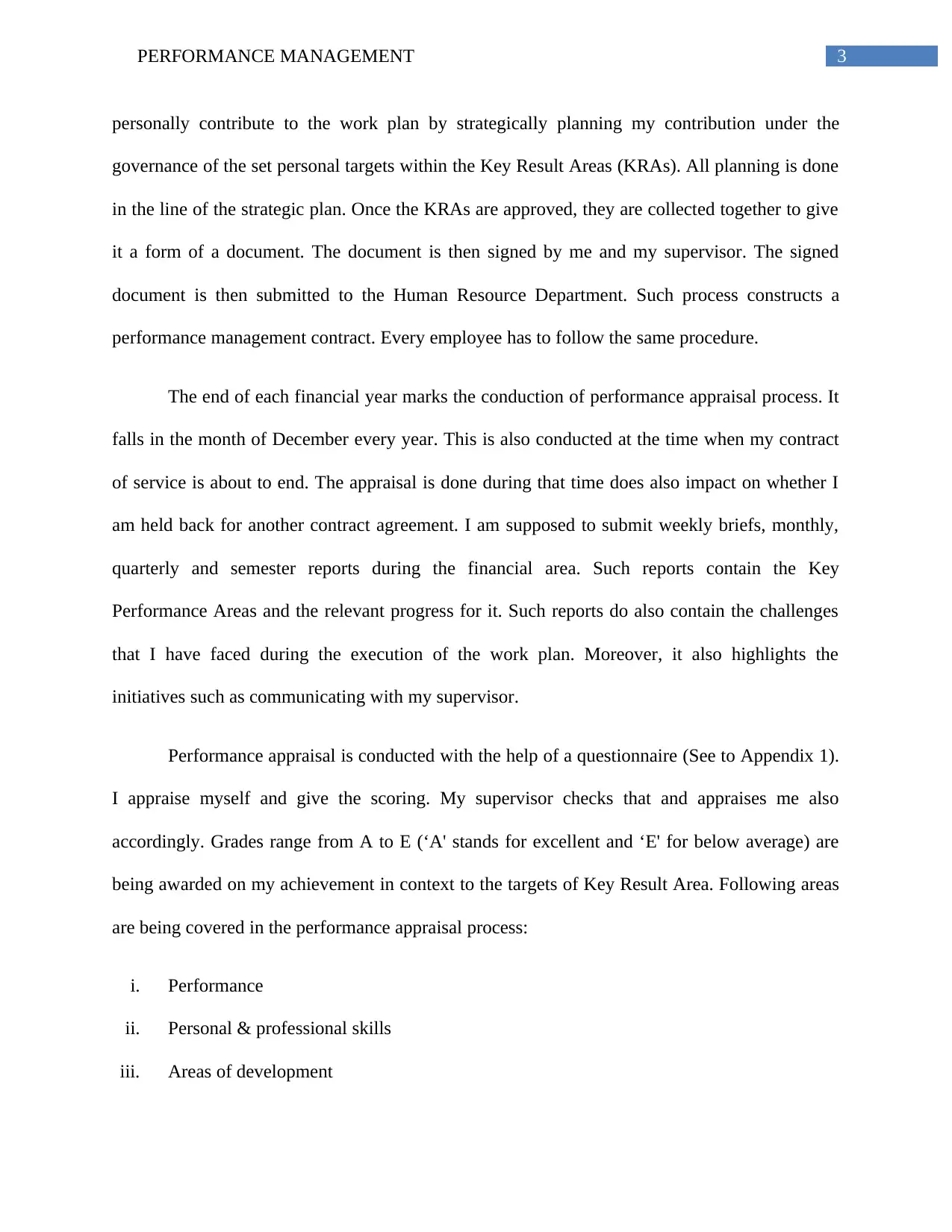
3PERFORMANCE MANAGEMENT
personally contribute to the work plan by strategically planning my contribution under the
governance of the set personal targets within the Key Result Areas (KRAs). All planning is done
in the line of the strategic plan. Once the KRAs are approved, they are collected together to give
it a form of a document. The document is then signed by me and my supervisor. The signed
document is then submitted to the Human Resource Department. Such process constructs a
performance management contract. Every employee has to follow the same procedure.
The end of each financial year marks the conduction of performance appraisal process. It
falls in the month of December every year. This is also conducted at the time when my contract
of service is about to end. The appraisal is done during that time does also impact on whether I
am held back for another contract agreement. I am supposed to submit weekly briefs, monthly,
quarterly and semester reports during the financial area. Such reports contain the Key
Performance Areas and the relevant progress for it. Such reports do also contain the challenges
that I have faced during the execution of the work plan. Moreover, it also highlights the
initiatives such as communicating with my supervisor.
Performance appraisal is conducted with the help of a questionnaire (See to Appendix 1).
I appraise myself and give the scoring. My supervisor checks that and appraises me also
accordingly. Grades range from A to E (‘A' stands for excellent and ‘E' for below average) are
being awarded on my achievement in context to the targets of Key Result Area. Following areas
are being covered in the performance appraisal process:
i. Performance
ii. Personal & professional skills
iii. Areas of development
personally contribute to the work plan by strategically planning my contribution under the
governance of the set personal targets within the Key Result Areas (KRAs). All planning is done
in the line of the strategic plan. Once the KRAs are approved, they are collected together to give
it a form of a document. The document is then signed by me and my supervisor. The signed
document is then submitted to the Human Resource Department. Such process constructs a
performance management contract. Every employee has to follow the same procedure.
The end of each financial year marks the conduction of performance appraisal process. It
falls in the month of December every year. This is also conducted at the time when my contract
of service is about to end. The appraisal is done during that time does also impact on whether I
am held back for another contract agreement. I am supposed to submit weekly briefs, monthly,
quarterly and semester reports during the financial area. Such reports contain the Key
Performance Areas and the relevant progress for it. Such reports do also contain the challenges
that I have faced during the execution of the work plan. Moreover, it also highlights the
initiatives such as communicating with my supervisor.
Performance appraisal is conducted with the help of a questionnaire (See to Appendix 1).
I appraise myself and give the scoring. My supervisor checks that and appraises me also
accordingly. Grades range from A to E (‘A' stands for excellent and ‘E' for below average) are
being awarded on my achievement in context to the targets of Key Result Area. Following areas
are being covered in the performance appraisal process:
i. Performance
ii. Personal & professional skills
iii. Areas of development
Paraphrase This Document
Need a fresh take? Get an instant paraphrase of this document with our AI Paraphraser
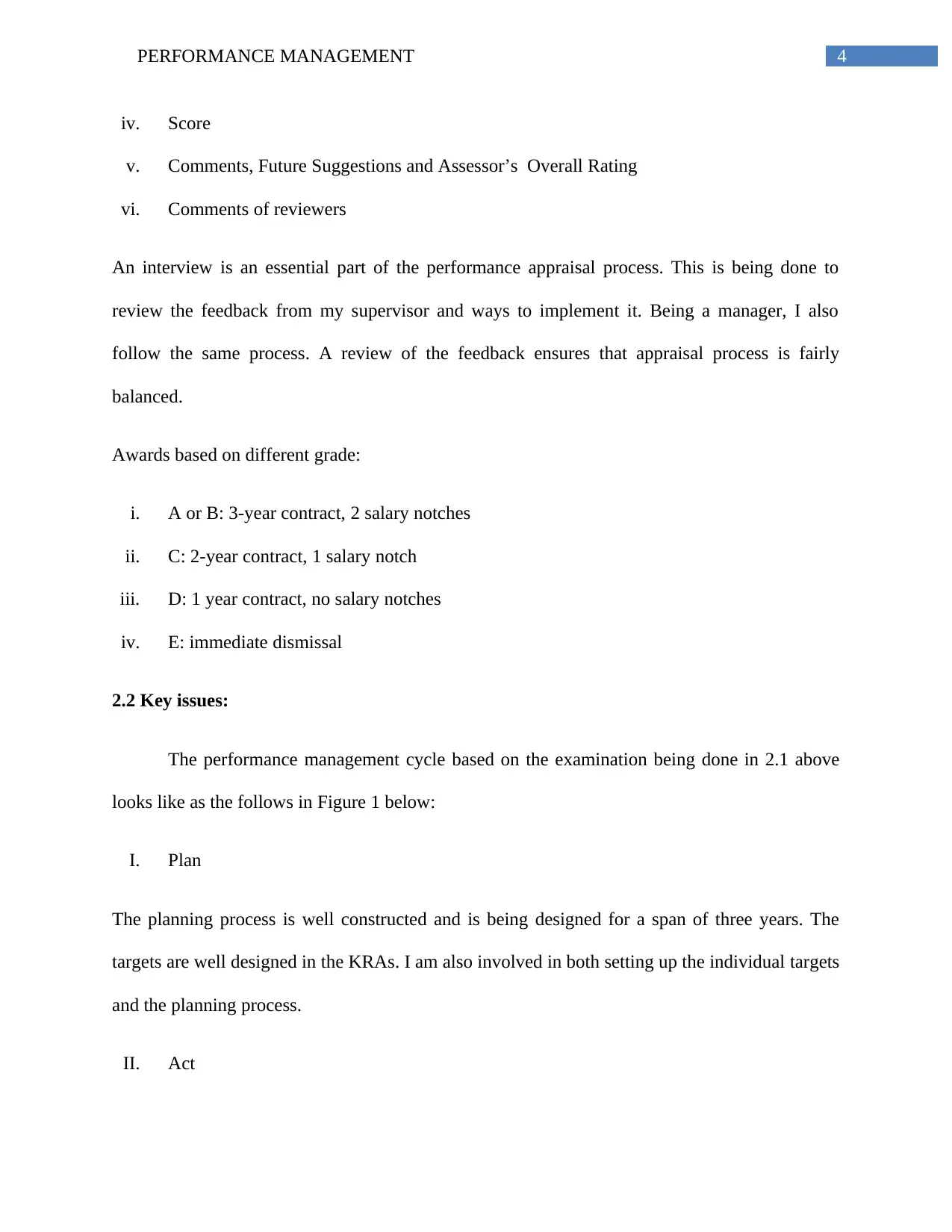
4PERFORMANCE MANAGEMENT
iv. Score
v. Comments, Future Suggestions and Assessor’s Overall Rating
vi. Comments of reviewers
An interview is an essential part of the performance appraisal process. This is being done to
review the feedback from my supervisor and ways to implement it. Being a manager, I also
follow the same process. A review of the feedback ensures that appraisal process is fairly
balanced.
Awards based on different grade:
i. A or B: 3-year contract, 2 salary notches
ii. C: 2-year contract, 1 salary notch
iii. D: 1 year contract, no salary notches
iv. E: immediate dismissal
2.2 Key issues:
The performance management cycle based on the examination being done in 2.1 above
looks like as the follows in Figure 1 below:
I. Plan
The planning process is well constructed and is being designed for a span of three years. The
targets are well designed in the KRAs. I am also involved in both setting up the individual targets
and the planning process.
II. Act
iv. Score
v. Comments, Future Suggestions and Assessor’s Overall Rating
vi. Comments of reviewers
An interview is an essential part of the performance appraisal process. This is being done to
review the feedback from my supervisor and ways to implement it. Being a manager, I also
follow the same process. A review of the feedback ensures that appraisal process is fairly
balanced.
Awards based on different grade:
i. A or B: 3-year contract, 2 salary notches
ii. C: 2-year contract, 1 salary notch
iii. D: 1 year contract, no salary notches
iv. E: immediate dismissal
2.2 Key issues:
The performance management cycle based on the examination being done in 2.1 above
looks like as the follows in Figure 1 below:
I. Plan
The planning process is well constructed and is being designed for a span of three years. The
targets are well designed in the KRAs. I am also involved in both setting up the individual targets
and the planning process.
II. Act
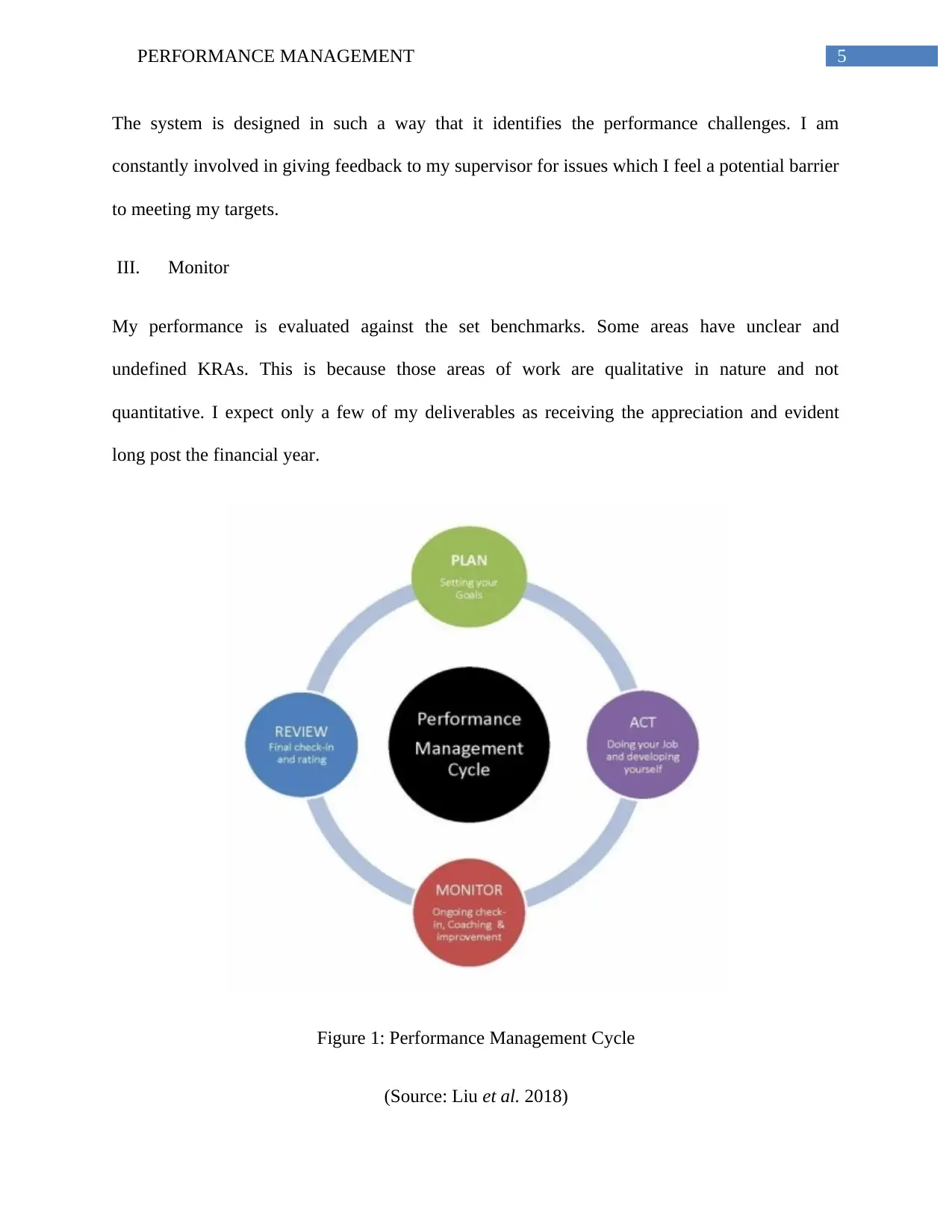
5PERFORMANCE MANAGEMENT
The system is designed in such a way that it identifies the performance challenges. I am
constantly involved in giving feedback to my supervisor for issues which I feel a potential barrier
to meeting my targets.
III. Monitor
My performance is evaluated against the set benchmarks. Some areas have unclear and
undefined KRAs. This is because those areas of work are qualitative in nature and not
quantitative. I expect only a few of my deliverables as receiving the appreciation and evident
long post the financial year.
Figure 1: Performance Management Cycle
(Source: Liu et al. 2018)
The system is designed in such a way that it identifies the performance challenges. I am
constantly involved in giving feedback to my supervisor for issues which I feel a potential barrier
to meeting my targets.
III. Monitor
My performance is evaluated against the set benchmarks. Some areas have unclear and
undefined KRAs. This is because those areas of work are qualitative in nature and not
quantitative. I expect only a few of my deliverables as receiving the appreciation and evident
long post the financial year.
Figure 1: Performance Management Cycle
(Source: Liu et al. 2018)
⊘ This is a preview!⊘
Do you want full access?
Subscribe today to unlock all pages.

Trusted by 1+ million students worldwide
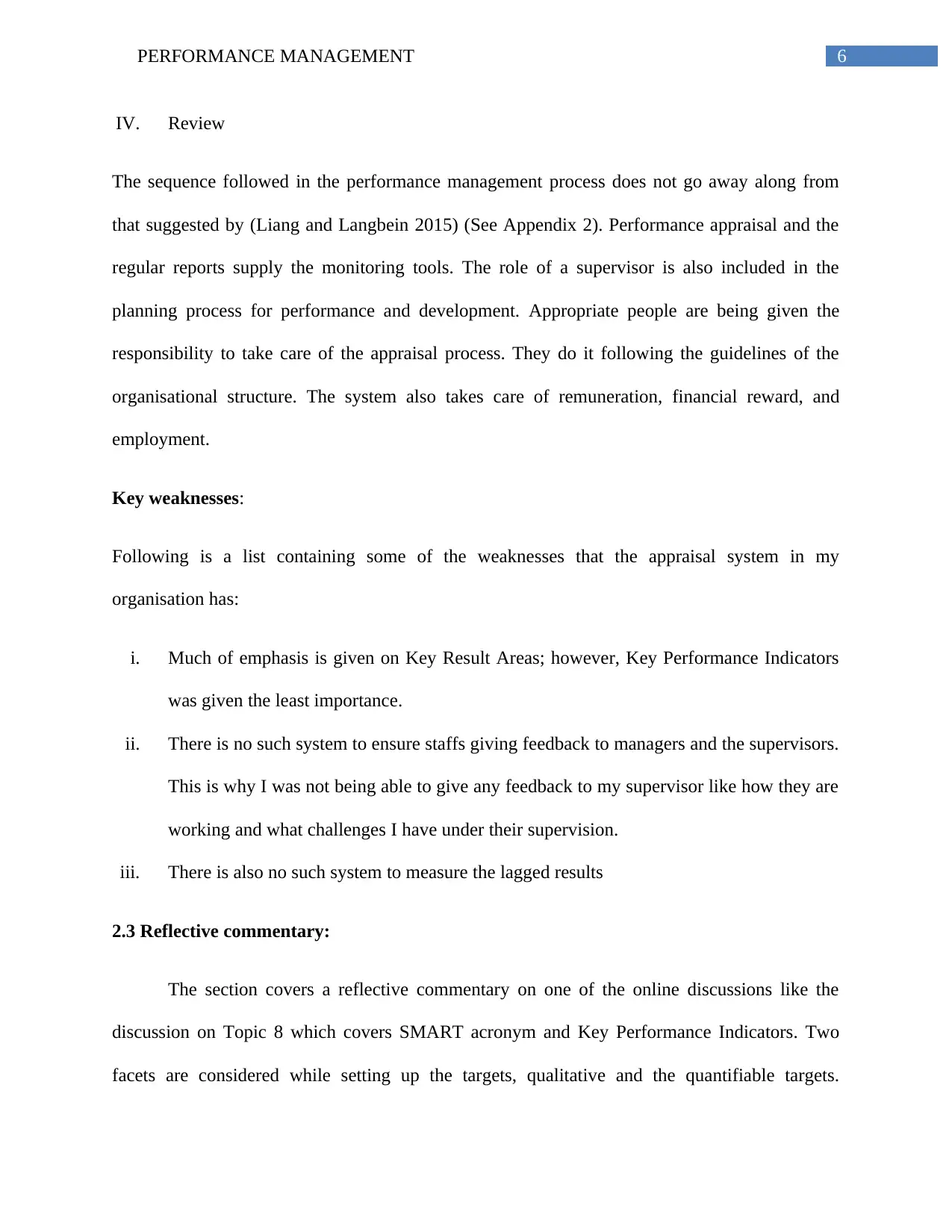
6PERFORMANCE MANAGEMENT
IV. Review
The sequence followed in the performance management process does not go away along from
that suggested by (Liang and Langbein 2015) (See Appendix 2). Performance appraisal and the
regular reports supply the monitoring tools. The role of a supervisor is also included in the
planning process for performance and development. Appropriate people are being given the
responsibility to take care of the appraisal process. They do it following the guidelines of the
organisational structure. The system also takes care of remuneration, financial reward, and
employment.
Key weaknesses:
Following is a list containing some of the weaknesses that the appraisal system in my
organisation has:
i. Much of emphasis is given on Key Result Areas; however, Key Performance Indicators
was given the least importance.
ii. There is no such system to ensure staffs giving feedback to managers and the supervisors.
This is why I was not being able to give any feedback to my supervisor like how they are
working and what challenges I have under their supervision.
iii. There is also no such system to measure the lagged results
2.3 Reflective commentary:
The section covers a reflective commentary on one of the online discussions like the
discussion on Topic 8 which covers SMART acronym and Key Performance Indicators. Two
facets are considered while setting up the targets, qualitative and the quantifiable targets.
IV. Review
The sequence followed in the performance management process does not go away along from
that suggested by (Liang and Langbein 2015) (See Appendix 2). Performance appraisal and the
regular reports supply the monitoring tools. The role of a supervisor is also included in the
planning process for performance and development. Appropriate people are being given the
responsibility to take care of the appraisal process. They do it following the guidelines of the
organisational structure. The system also takes care of remuneration, financial reward, and
employment.
Key weaknesses:
Following is a list containing some of the weaknesses that the appraisal system in my
organisation has:
i. Much of emphasis is given on Key Result Areas; however, Key Performance Indicators
was given the least importance.
ii. There is no such system to ensure staffs giving feedback to managers and the supervisors.
This is why I was not being able to give any feedback to my supervisor like how they are
working and what challenges I have under their supervision.
iii. There is also no such system to measure the lagged results
2.3 Reflective commentary:
The section covers a reflective commentary on one of the online discussions like the
discussion on Topic 8 which covers SMART acronym and Key Performance Indicators. Two
facets are considered while setting up the targets, qualitative and the quantifiable targets.
Paraphrase This Document
Need a fresh take? Get an instant paraphrase of this document with our AI Paraphraser
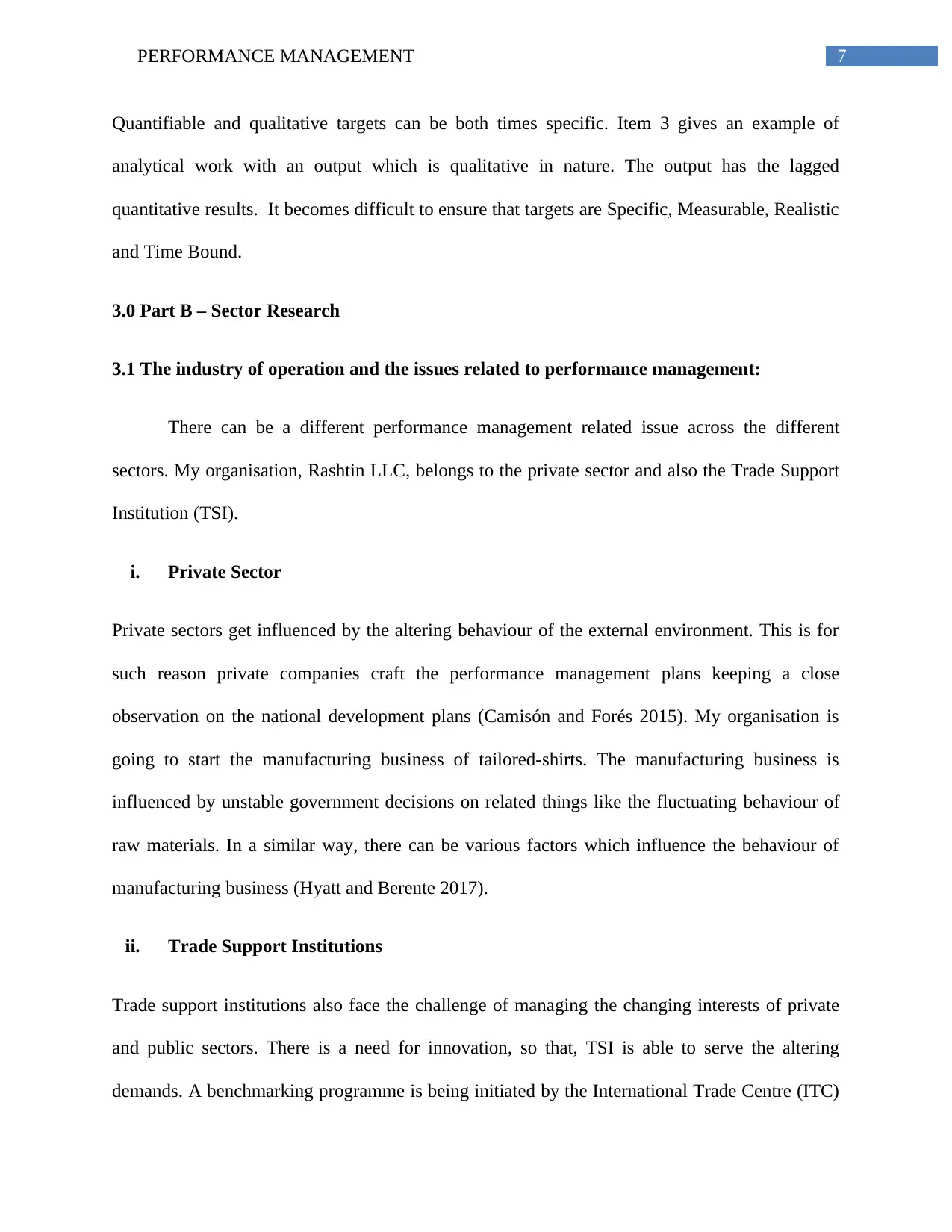
7PERFORMANCE MANAGEMENT
Quantifiable and qualitative targets can be both times specific. Item 3 gives an example of
analytical work with an output which is qualitative in nature. The output has the lagged
quantitative results. It becomes difficult to ensure that targets are Specific, Measurable, Realistic
and Time Bound.
3.0 Part B – Sector Research
3.1 The industry of operation and the issues related to performance management:
There can be a different performance management related issue across the different
sectors. My organisation, Rashtin LLC, belongs to the private sector and also the Trade Support
Institution (TSI).
i. Private Sector
Private sectors get influenced by the altering behaviour of the external environment. This is for
such reason private companies craft the performance management plans keeping a close
observation on the national development plans (Camisón and Forés 2015). My organisation is
going to start the manufacturing business of tailored-shirts. The manufacturing business is
influenced by unstable government decisions on related things like the fluctuating behaviour of
raw materials. In a similar way, there can be various factors which influence the behaviour of
manufacturing business (Hyatt and Berente 2017).
ii. Trade Support Institutions
Trade support institutions also face the challenge of managing the changing interests of private
and public sectors. There is a need for innovation, so that, TSI is able to serve the altering
demands. A benchmarking programme is being initiated by the International Trade Centre (ITC)
Quantifiable and qualitative targets can be both times specific. Item 3 gives an example of
analytical work with an output which is qualitative in nature. The output has the lagged
quantitative results. It becomes difficult to ensure that targets are Specific, Measurable, Realistic
and Time Bound.
3.0 Part B – Sector Research
3.1 The industry of operation and the issues related to performance management:
There can be a different performance management related issue across the different
sectors. My organisation, Rashtin LLC, belongs to the private sector and also the Trade Support
Institution (TSI).
i. Private Sector
Private sectors get influenced by the altering behaviour of the external environment. This is for
such reason private companies craft the performance management plans keeping a close
observation on the national development plans (Camisón and Forés 2015). My organisation is
going to start the manufacturing business of tailored-shirts. The manufacturing business is
influenced by unstable government decisions on related things like the fluctuating behaviour of
raw materials. In a similar way, there can be various factors which influence the behaviour of
manufacturing business (Hyatt and Berente 2017).
ii. Trade Support Institutions
Trade support institutions also face the challenge of managing the changing interests of private
and public sectors. There is a need for innovation, so that, TSI is able to serve the altering
demands. A benchmarking programme is being initiated by the International Trade Centre (ITC)
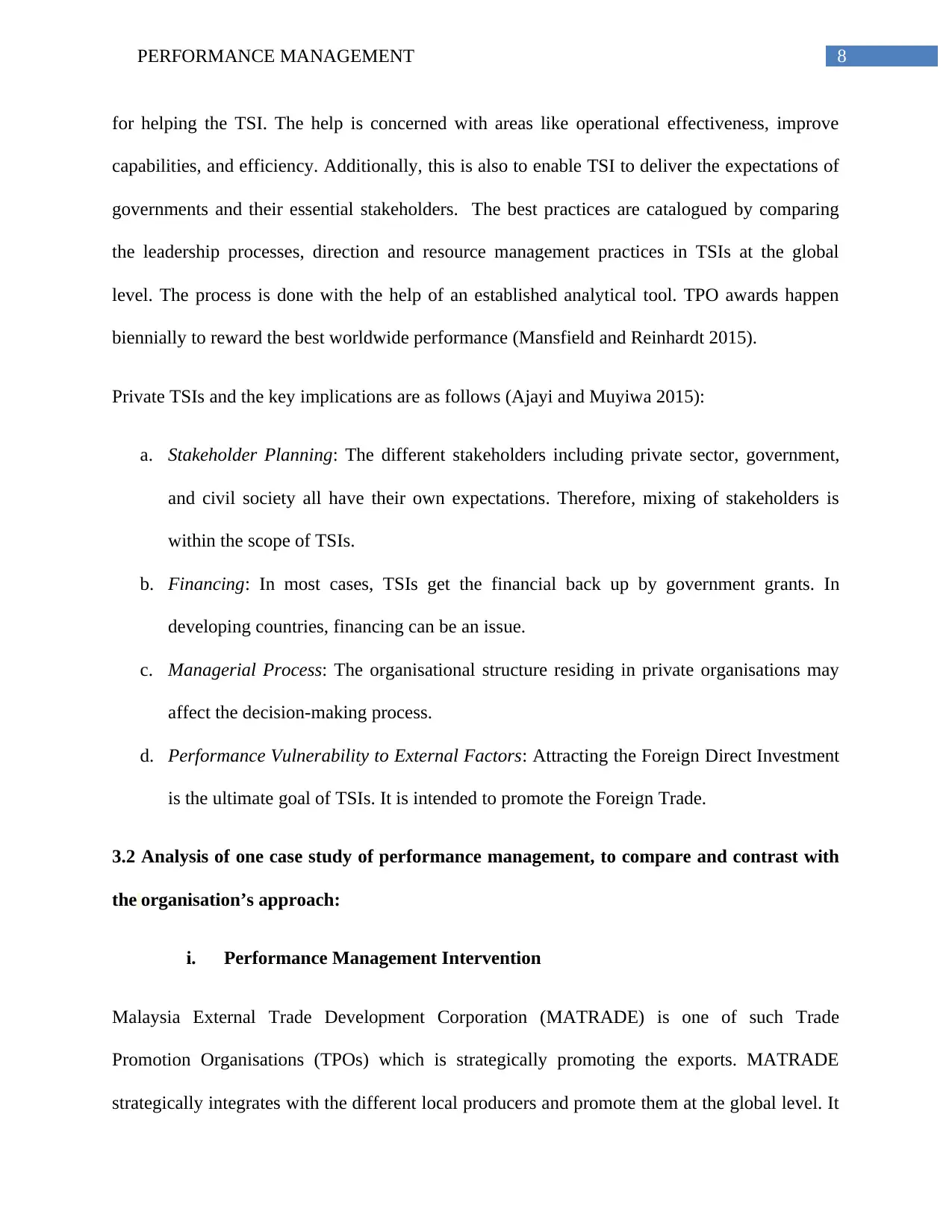
8PERFORMANCE MANAGEMENT
for helping the TSI. The help is concerned with areas like operational effectiveness, improve
capabilities, and efficiency. Additionally, this is also to enable TSI to deliver the expectations of
governments and their essential stakeholders. The best practices are catalogued by comparing
the leadership processes, direction and resource management practices in TSIs at the global
level. The process is done with the help of an established analytical tool. TPO awards happen
biennially to reward the best worldwide performance (Mansfield and Reinhardt 2015).
Private TSIs and the key implications are as follows (Ajayi and Muyiwa 2015):
a. Stakeholder Planning: The different stakeholders including private sector, government,
and civil society all have their own expectations. Therefore, mixing of stakeholders is
within the scope of TSIs.
b. Financing: In most cases, TSIs get the financial back up by government grants. In
developing countries, financing can be an issue.
c. Managerial Process: The organisational structure residing in private organisations may
affect the decision-making process.
d. Performance Vulnerability to External Factors: Attracting the Foreign Direct Investment
is the ultimate goal of TSIs. It is intended to promote the Foreign Trade.
3.2 Analysis of one case study of performance management, to compare and contrast with
the organisation’s approach:
i. Performance Management Intervention
Malaysia External Trade Development Corporation (MATRADE) is one of such Trade
Promotion Organisations (TPOs) which is strategically promoting the exports. MATRADE
strategically integrates with the different local producers and promote them at the global level. It
for helping the TSI. The help is concerned with areas like operational effectiveness, improve
capabilities, and efficiency. Additionally, this is also to enable TSI to deliver the expectations of
governments and their essential stakeholders. The best practices are catalogued by comparing
the leadership processes, direction and resource management practices in TSIs at the global
level. The process is done with the help of an established analytical tool. TPO awards happen
biennially to reward the best worldwide performance (Mansfield and Reinhardt 2015).
Private TSIs and the key implications are as follows (Ajayi and Muyiwa 2015):
a. Stakeholder Planning: The different stakeholders including private sector, government,
and civil society all have their own expectations. Therefore, mixing of stakeholders is
within the scope of TSIs.
b. Financing: In most cases, TSIs get the financial back up by government grants. In
developing countries, financing can be an issue.
c. Managerial Process: The organisational structure residing in private organisations may
affect the decision-making process.
d. Performance Vulnerability to External Factors: Attracting the Foreign Direct Investment
is the ultimate goal of TSIs. It is intended to promote the Foreign Trade.
3.2 Analysis of one case study of performance management, to compare and contrast with
the organisation’s approach:
i. Performance Management Intervention
Malaysia External Trade Development Corporation (MATRADE) is one of such Trade
Promotion Organisations (TPOs) which is strategically promoting the exports. MATRADE
strategically integrates with the different local producers and promote them at the global level. It
⊘ This is a preview!⊘
Do you want full access?
Subscribe today to unlock all pages.

Trusted by 1+ million students worldwide
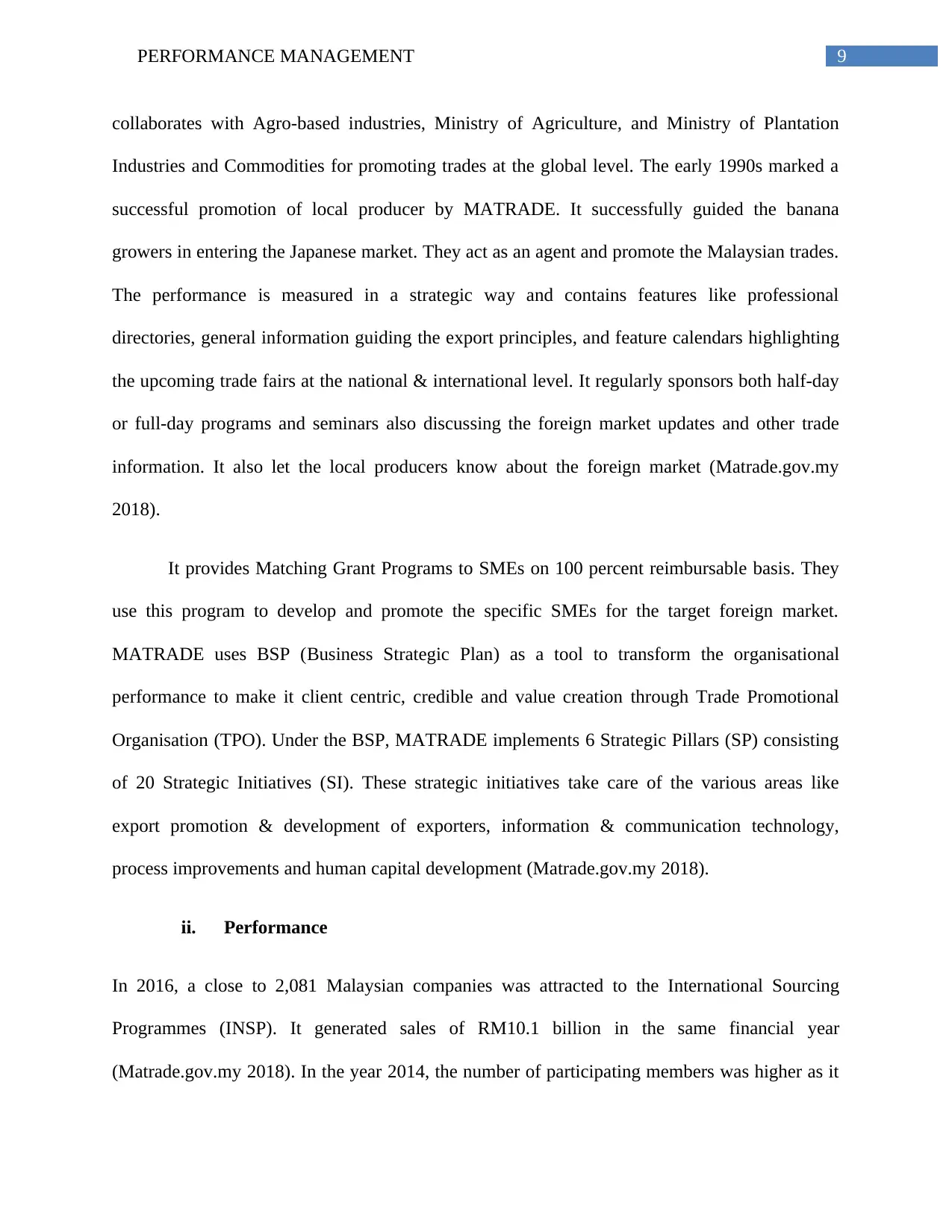
9PERFORMANCE MANAGEMENT
collaborates with Agro-based industries, Ministry of Agriculture, and Ministry of Plantation
Industries and Commodities for promoting trades at the global level. The early 1990s marked a
successful promotion of local producer by MATRADE. It successfully guided the banana
growers in entering the Japanese market. They act as an agent and promote the Malaysian trades.
The performance is measured in a strategic way and contains features like professional
directories, general information guiding the export principles, and feature calendars highlighting
the upcoming trade fairs at the national & international level. It regularly sponsors both half-day
or full-day programs and seminars also discussing the foreign market updates and other trade
information. It also let the local producers know about the foreign market (Matrade.gov.my
2018).
It provides Matching Grant Programs to SMEs on 100 percent reimbursable basis. They
use this program to develop and promote the specific SMEs for the target foreign market.
MATRADE uses BSP (Business Strategic Plan) as a tool to transform the organisational
performance to make it client centric, credible and value creation through Trade Promotional
Organisation (TPO). Under the BSP, MATRADE implements 6 Strategic Pillars (SP) consisting
of 20 Strategic Initiatives (SI). These strategic initiatives take care of the various areas like
export promotion & development of exporters, information & communication technology,
process improvements and human capital development (Matrade.gov.my 2018).
ii. Performance
In 2016, a close to 2,081 Malaysian companies was attracted to the International Sourcing
Programmes (INSP). It generated sales of RM10.1 billion in the same financial year
(Matrade.gov.my 2018). In the year 2014, the number of participating members was higher as it
collaborates with Agro-based industries, Ministry of Agriculture, and Ministry of Plantation
Industries and Commodities for promoting trades at the global level. The early 1990s marked a
successful promotion of local producer by MATRADE. It successfully guided the banana
growers in entering the Japanese market. They act as an agent and promote the Malaysian trades.
The performance is measured in a strategic way and contains features like professional
directories, general information guiding the export principles, and feature calendars highlighting
the upcoming trade fairs at the national & international level. It regularly sponsors both half-day
or full-day programs and seminars also discussing the foreign market updates and other trade
information. It also let the local producers know about the foreign market (Matrade.gov.my
2018).
It provides Matching Grant Programs to SMEs on 100 percent reimbursable basis. They
use this program to develop and promote the specific SMEs for the target foreign market.
MATRADE uses BSP (Business Strategic Plan) as a tool to transform the organisational
performance to make it client centric, credible and value creation through Trade Promotional
Organisation (TPO). Under the BSP, MATRADE implements 6 Strategic Pillars (SP) consisting
of 20 Strategic Initiatives (SI). These strategic initiatives take care of the various areas like
export promotion & development of exporters, information & communication technology,
process improvements and human capital development (Matrade.gov.my 2018).
ii. Performance
In 2016, a close to 2,081 Malaysian companies was attracted to the International Sourcing
Programmes (INSP). It generated sales of RM10.1 billion in the same financial year
(Matrade.gov.my 2018). In the year 2014, the number of participating members was higher as it
Paraphrase This Document
Need a fresh take? Get an instant paraphrase of this document with our AI Paraphraser
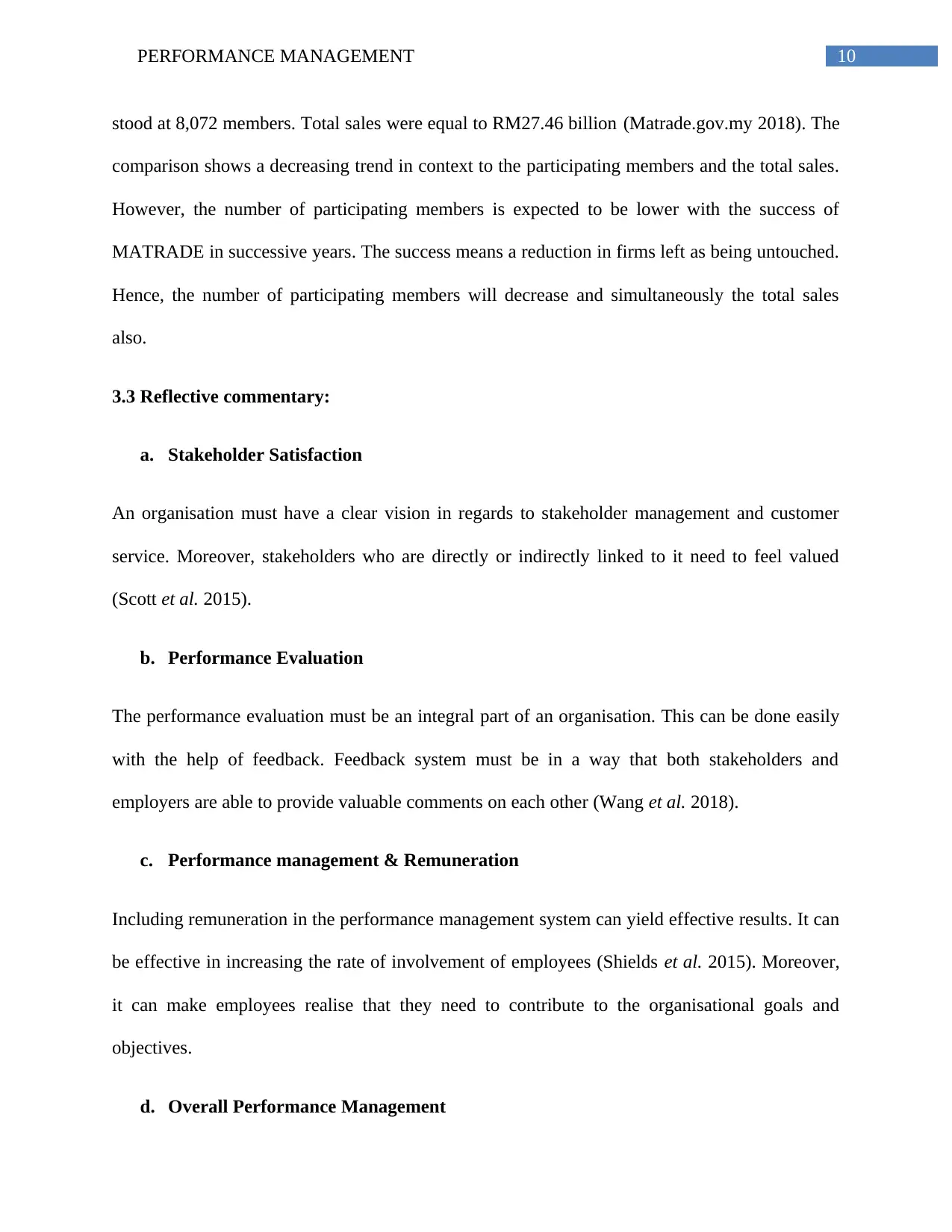
10PERFORMANCE MANAGEMENT
stood at 8,072 members. Total sales were equal to RM27.46 billion (Matrade.gov.my 2018). The
comparison shows a decreasing trend in context to the participating members and the total sales.
However, the number of participating members is expected to be lower with the success of
MATRADE in successive years. The success means a reduction in firms left as being untouched.
Hence, the number of participating members will decrease and simultaneously the total sales
also.
3.3 Reflective commentary:
a. Stakeholder Satisfaction
An organisation must have a clear vision in regards to stakeholder management and customer
service. Moreover, stakeholders who are directly or indirectly linked to it need to feel valued
(Scott et al. 2015).
b. Performance Evaluation
The performance evaluation must be an integral part of an organisation. This can be done easily
with the help of feedback. Feedback system must be in a way that both stakeholders and
employers are able to provide valuable comments on each other (Wang et al. 2018).
c. Performance management & Remuneration
Including remuneration in the performance management system can yield effective results. It can
be effective in increasing the rate of involvement of employees (Shields et al. 2015). Moreover,
it can make employees realise that they need to contribute to the organisational goals and
objectives.
d. Overall Performance Management
stood at 8,072 members. Total sales were equal to RM27.46 billion (Matrade.gov.my 2018). The
comparison shows a decreasing trend in context to the participating members and the total sales.
However, the number of participating members is expected to be lower with the success of
MATRADE in successive years. The success means a reduction in firms left as being untouched.
Hence, the number of participating members will decrease and simultaneously the total sales
also.
3.3 Reflective commentary:
a. Stakeholder Satisfaction
An organisation must have a clear vision in regards to stakeholder management and customer
service. Moreover, stakeholders who are directly or indirectly linked to it need to feel valued
(Scott et al. 2015).
b. Performance Evaluation
The performance evaluation must be an integral part of an organisation. This can be done easily
with the help of feedback. Feedback system must be in a way that both stakeholders and
employers are able to provide valuable comments on each other (Wang et al. 2018).
c. Performance management & Remuneration
Including remuneration in the performance management system can yield effective results. It can
be effective in increasing the rate of involvement of employees (Shields et al. 2015). Moreover,
it can make employees realise that they need to contribute to the organisational goals and
objectives.
d. Overall Performance Management
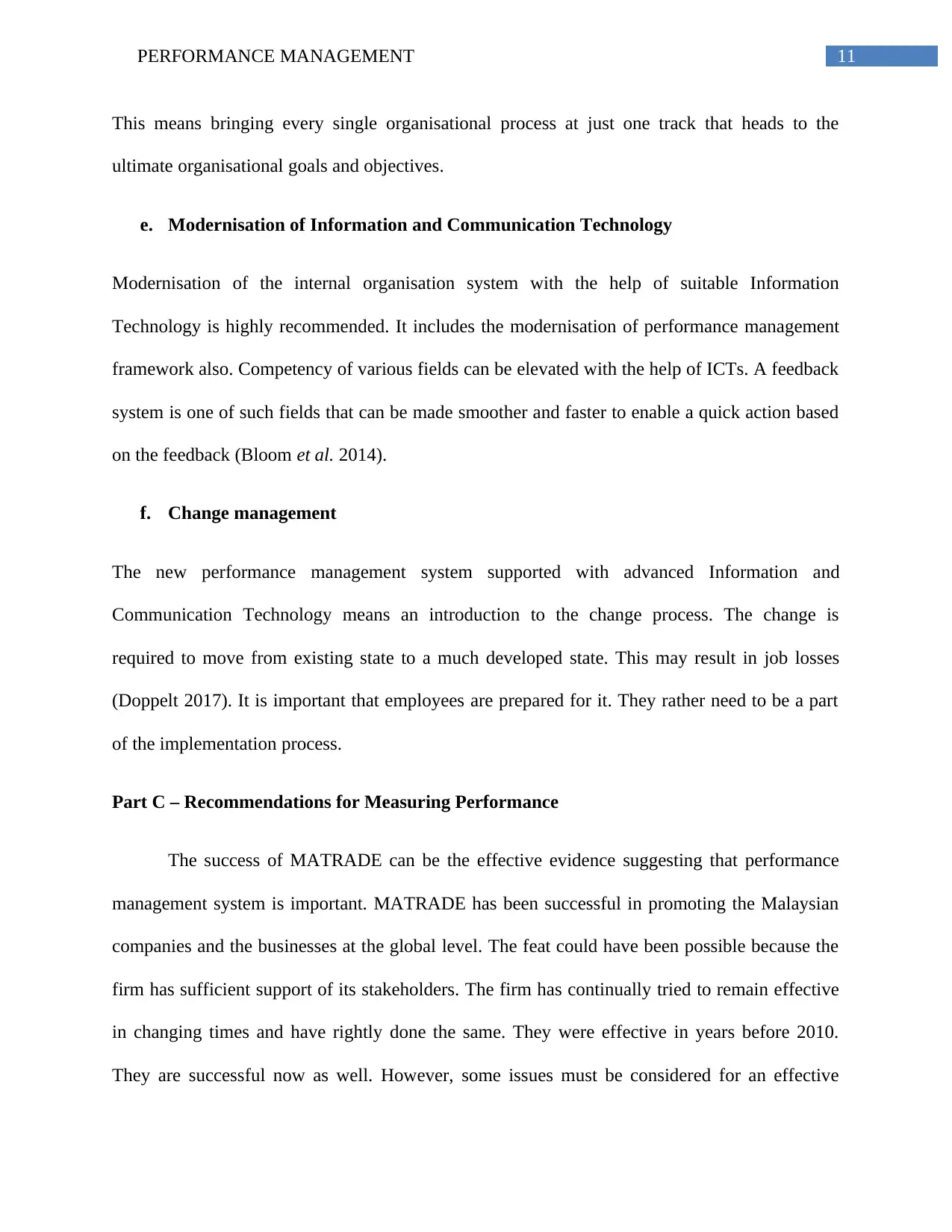
11PERFORMANCE MANAGEMENT
This means bringing every single organisational process at just one track that heads to the
ultimate organisational goals and objectives.
e. Modernisation of Information and Communication Technology
Modernisation of the internal organisation system with the help of suitable Information
Technology is highly recommended. It includes the modernisation of performance management
framework also. Competency of various fields can be elevated with the help of ICTs. A feedback
system is one of such fields that can be made smoother and faster to enable a quick action based
on the feedback (Bloom et al. 2014).
f. Change management
The new performance management system supported with advanced Information and
Communication Technology means an introduction to the change process. The change is
required to move from existing state to a much developed state. This may result in job losses
(Doppelt 2017). It is important that employees are prepared for it. They rather need to be a part
of the implementation process.
Part C – Recommendations for Measuring Performance
The success of MATRADE can be the effective evidence suggesting that performance
management system is important. MATRADE has been successful in promoting the Malaysian
companies and the businesses at the global level. The feat could have been possible because the
firm has sufficient support of its stakeholders. The firm has continually tried to remain effective
in changing times and have rightly done the same. They were effective in years before 2010.
They are successful now as well. However, some issues must be considered for an effective
This means bringing every single organisational process at just one track that heads to the
ultimate organisational goals and objectives.
e. Modernisation of Information and Communication Technology
Modernisation of the internal organisation system with the help of suitable Information
Technology is highly recommended. It includes the modernisation of performance management
framework also. Competency of various fields can be elevated with the help of ICTs. A feedback
system is one of such fields that can be made smoother and faster to enable a quick action based
on the feedback (Bloom et al. 2014).
f. Change management
The new performance management system supported with advanced Information and
Communication Technology means an introduction to the change process. The change is
required to move from existing state to a much developed state. This may result in job losses
(Doppelt 2017). It is important that employees are prepared for it. They rather need to be a part
of the implementation process.
Part C – Recommendations for Measuring Performance
The success of MATRADE can be the effective evidence suggesting that performance
management system is important. MATRADE has been successful in promoting the Malaysian
companies and the businesses at the global level. The feat could have been possible because the
firm has sufficient support of its stakeholders. The firm has continually tried to remain effective
in changing times and have rightly done the same. They were effective in years before 2010.
They are successful now as well. However, some issues must be considered for an effective
⊘ This is a preview!⊘
Do you want full access?
Subscribe today to unlock all pages.

Trusted by 1+ million students worldwide
1 out of 20
Related Documents
Your All-in-One AI-Powered Toolkit for Academic Success.
+13062052269
info@desklib.com
Available 24*7 on WhatsApp / Email
![[object Object]](/_next/static/media/star-bottom.7253800d.svg)
Unlock your academic potential
Copyright © 2020–2025 A2Z Services. All Rights Reserved. Developed and managed by ZUCOL.





